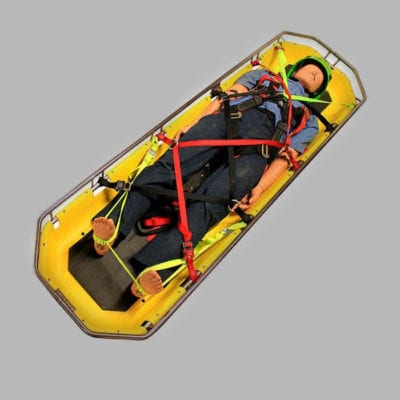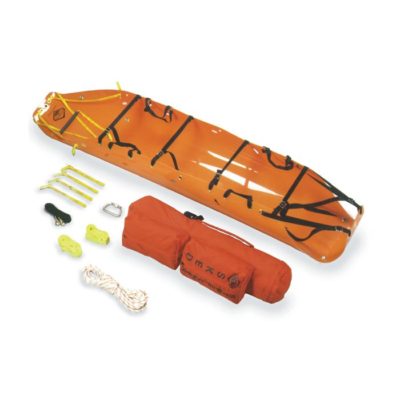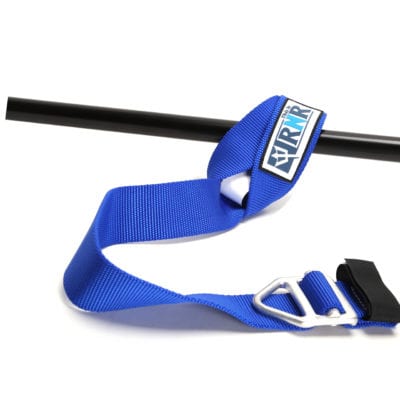Your cart is currently empty!
Which Patient Tie-In System is Right For You?

A COMPARATIVE CONTRAST OF RESCUE LITTER PATIENT TIE-IN SYSTEMS
Dana Jordan is the President and owner of Cascade Rescue Company since 1999. He was a member of the Alpental Ski Patrol, Schweitzer Ski Patrol and several SAR teams in the Pacific NW and has been a contributor to several trade and technical rescue publications and has consulted with numerous SAR, Fire/Tech Rescue Units and Ski Patrols worldwide.
It should be noted that this article was written simply as an overview of available options by a manufacturer of litters. Cascade Rescue Company is a reseller of all the above-mentioned products but does not make any of the devices mentioned other than basic four strap systems installed as a standard item on their litters.
OVERVIEW
There are many “patient tie-in” systems in use today. This article explores the most commonly used systems, their components and provides a perspective of these systems from a leading manufacturer of litters. All systems reviewed are of exceptional quality and can be adapted for use on a backboard.
We distinguish these tie-in systems in two categories:
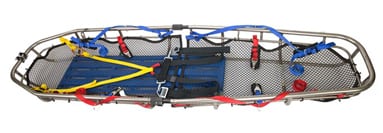

Complete Tie-in Systems: These systems tend to be a bit more complex, but are made to be intuitive and provide integrated features allowing the rescuer to handle many different rescue situations without adding to or improvising.
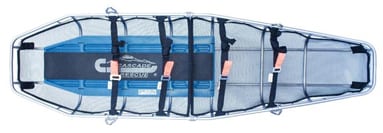

Simple Tie-in Systems: These systems range from pre-rigged, specialized application uses like basic immobilization, to simple single or double section webbing or standard horizontal straps.
COMPLETE PATIENT TIE-IN SYSTEMS
Two widely used complete systems are listed below in the order of most to least used, followed by a chart highlighting features, strengths, etc. A third system that has been recently introduced will also be discussed.
1. CMC PATIENT TIE-IN SYSTEM
This system is widely used and in its most basic form can be ordered in versions designed for one or two piece litters. It is comprised of two long lengths of 1” tubular webbing of differing colors that form a cross pattern over the patient from head to toe. One end of each of these lengths is fixed to the foot of the litter and the strap is then threaded through a ring located at the center section of the litter. It has two “floating” rings positioned between the bottom fixation point and where the strap is ultimately threaded through a metal ladder lock buckle at the head of the litter. On the opposite side of the litter of these two floating rings is a short strap with an upward facing hook. All hooks have a section of padding beneath them to protect the patient. When a patient is ready to be placed into the litter, the rings are unhooked, each section of different colored webbing is then laid outside the litter on the sides. Tying the patient in is then a simple matter of pulling the webbing over the patient, snapping the rings into the hooks and tensioning the system by pulling the end of the strap at the head of the litter through the ladder lock buckle.
Pros:
- Provides a means for fast patient restraint
- Very simple, easy to use and lightweight (2.9lbs)
- Padding underneath hardware for patient comfort
- Good for basic immobilization in a horizontal orientation
Cons:
- User must select a one or two piece litter design.
- As a base product, there is no way to restrain the patient for vertical applications. Vertical operations require either the purchase of the optional Pelvic Harness or improvisation with other webbing or harnesses and it has no foot stirrups.
- Expensive – compared to other options, we felt the total utility the system offered was lacking given the price point
- Other than a rating for the webbing (4,000lbs), there are no other hardware strengths rating provided. CMC indicates the entire system will “hold” a 500lb load.
2. PMI FAST PATIENT RESTRAINT SYSTEM
We definitely consider this system to be a “complete” system for use in both horizontal and vertical operations right out of the box. However, because it is more fully featured, it is more complex and somewhat less intuitive for operator use. Instead of two long lengths of webbing that form the main component of the system, it uses four lengths. These lengths then thread through a ring attached to the litter secondary railing. Instead of using a series of hooks to snap rings into, this system uses a series of adjustable plastic/metal Duraflex buckles, (each rated to 500lbs). The system also includes two adjustable straps that cross over the patient’s chest and shoulders, effectively securing them to the litter if a “head down” situation occurred as well as an additional strap to attach to a harness. Properly secured, the litter can be oriented in virtually any position without the patient sliding more than an inch in any direction.


$291.25 (does not include seat harness)
Pros:
- Can be ordered pre-installed if ordered with a new litter
- Works for one or two piece units
- Very versatile and full-featured with no need for expensive add-ons
- Includes tie-in for seat harness
- Includes wide, easily adjustable foot stirrups
Cons:
- Somewhat complicated, less intuitive and challenging to install initially
- Does not include Pelvic/seat harness
- At 3.75lbs it is a bit on the heavy side
- Buckles – work well, but an upgrade could be made and buckle padding added for patient comfort.
3. ROCK-N-RESCUE PATIENT PACKAGING SYSTEM
A relatively new product from RNR, this system offers some substantial upgrades from the typical “X pattern” tie-in system. The system is comprised of two longer lengths of webbing that thread through a ring on each side. Unfortunately, this means it is suitable for one piece litters only unless you are willing to un-thread and re-thread webbing from loops and buckles. However, the system features very nice ISC “Cobra” style adjustable buckles rated over 3,500lbs and the rings are lightweight, exceptionally strong (4,400lbs) machined aluminum. Because the rings are thicker, tensioning the system is much easier and smoother than other systems.


$215 (Does not include seat harness)
Pros:
- Exceptional value – better buckles, rings and stronger webbing
- Includes easily adjustable, wide foot stirrups
- Includes rigging for Pelvic/seat harness
- Intuitive and easy to use
- Lightweight (2.9lbs)
Cons:
- Not the best solution for two-piece litters.
SIMPLE TIE-IN SYSTEMS
1. CMC FAST LOOP LITTER STRAPS
Fastloops are not a system unto themselves but are comprised of four blue and four red straps with rings on the ends. These straps can be girth hitched to the litter – four on each side. The loops serve as an easy way to thread one long length of webbing through and easily tie-in a patient and tension the system.


$71
Pros:
- Simple and lightweight (12.9oz – not including 20’ webbing)
- Intuitive
- Relatively inexpensive
- High breaking strength (1500lbs)
Cons:
- Does not come with the 20-foot section of 1” webbing required to complete the system
- Requires “threading” of the webbing through the loops for each use
- Webbing must be tied to the litter to complete tensioning.
2. STANDARD FOUR HORIZONTAL BUCKLE/STRAP SYSTEMS
Generally speaking, every litter purchased today will come with four straps affixed to the secondary railing. These straps may then be fastened horizontally across the patient or in a simple “X” pattern. The buckles range from basic spring loaded “tourniquet” style buckles to upgraded “pass-through” styles.
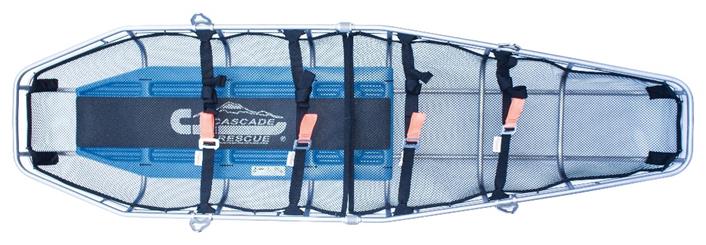

($Included w/ most litters)
Pros:
- Included with litter at no additional charge
- Effective for basic stabilization in a horizontal configuration
- All buckles/straps exceeded 500lb breaking strength
Cons:
- Patient may experience greater side to side or end to end movement
- May not be strong enough for more challenging situations
A WORD ABOUT BUCKLES
There are a plethora of buckles available for fast rigging of patient tie-in systems. Here are our opinions on the subject.
All plastic Duraflex style buckles: We’re not a fan of these. While they work well for many applications, they don’t usually come with any weight rating, can be difficult to release and tend to crack in cold weather or when stepped on.
Tourniquet buckles: Better than plastic, but are subject to rusting/binding if not maintained. Strength ratings vary from none to about 400lbs depending on size and manufacturer.
Pass-through style buckles: If equipped with a quick release strap/tab, these buckles tend to be as strong as the webbing they are attached to (2,000 to 4,000lbs). They are often included as a stock component of litters, are lightweight and generally easy to use. The downside is that the pass-through component can come off the strap and be lost, rendering the buckle useless. They also are somewhat less intuitive than other buckles.
Metal/plastic DuraflexTM buckles: These buckles have metal internal components with a plastic outer shell. They work well and are much stronger than the all plastic variety (500lbs). However, they can crack or be crushed if stepped on and suffer the same cold weather issues due to the outer plastic shell. They work, but we feel better options are available. This is a trade-off – better buckles are more expensive.
CobraTM style buckles: In terms of strength and general ease of use, this type of buckle is an excellent choice. The downside is that they are often quite expensive and are much heavier than others. A nice compromise are those offered by ISCTM. They feature an aluminum outer shell and steel internal mechanism. They are also less expensive than the traditional CobraTM style offered by AustiAlpinTM.
Hooks: Are usually very fast and efficient but can be prone to snagging another rigging, clothing, brush, etc. Can also be difficult to remove rings with gloved hands. We’ve not been able to locate breaking strengths for the most commonly used devices.
Cam-Lock buckles: These buckles are not generally used in patient tie-in systems. While strong and light, they can be difficult to thread and may slow overall packaging. However, they could very well be used in traditional “X” pattern systems in place of tying knots. A cam-lock buckle could be attached to a short loop of webbing girth-hitched to the bottom of the litter. The entire system could then be tensioned by pulling the straps taught through the buckles.
THE BOTTOM LINE…..
For vertical work: The PMI FAST System is our choice if the majority of your rescues include high incline work where the requirement of the rescue may put the patient in many different orientations. As is, it is a complete solution for all orientations. Adding some form of simple seat harness adds to patient comfort and security, but is not an absolute necessity. While requiring a bit more training due to its complexity, this system does it all. If you want a more simple system, the foot stirrups, chest “cross straps” and harness strap can be easily removed. It is suitable for both one and two piece litters.
For basic immobilization: We like the RNR Patient Packaging System. This system won our vote because it does the job required of most rescue situations and includes superior hardware at an excellent price. It also features rich enough that if required can be used in some vertical operations with a minimum of additional rigging to better secure the patient. The downside is that it is really designed for one piece litters. If you want a more simple “all in one” type system, we recommend the PMI FAST System and remove some of the components to improve simplicity.
If you know vertical is a remote possibility…. The CMC Fastloops are great for those who really like to have a basic inter-laced “X” pattern system. If you need more, a more comprehensive “Complete” system should be considered. If you have this system and need to go vertical, improvised webbing and a seat harness could be used if rigged appropriately. It is also priced competitively.
*Unless noted, all photos courtesy of Cascade Rescue Company
COURTESY OF THE MOUNTAIN RESCUE ASSOCIATION
Need help selecting the best PATIENT TIE-IN SYSTEM for your application?



